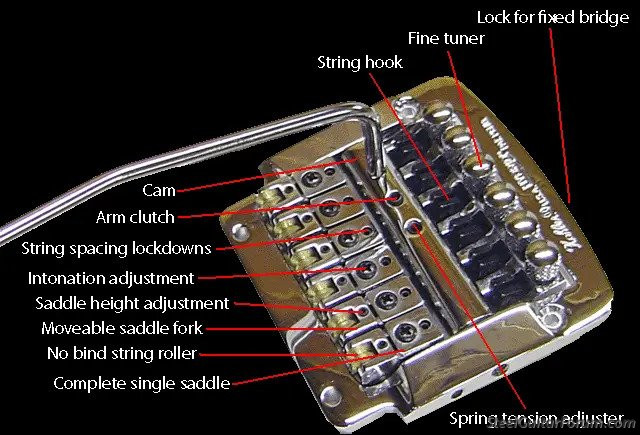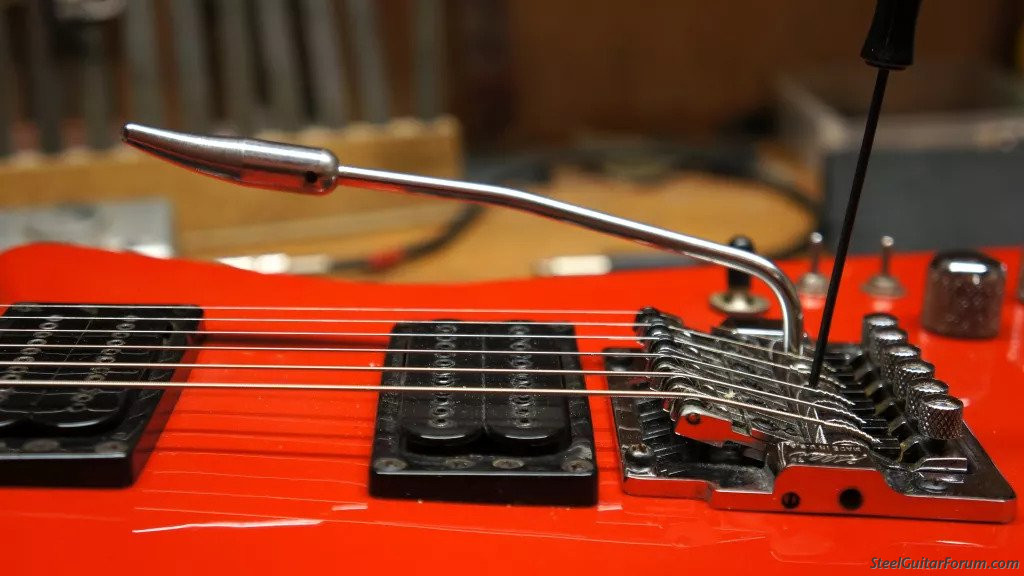| Author |
Topic: Duesenberg multibender issues |
Peter Leavenworth
From:
Madbury, New Hampshire, USA
|
 Posted 9 Oct 2021 5:18 am
Posted 9 Oct 2021 5:18 am |
|
For those of us for whom messing with pedal steel mechanisms isn't enough of a discouragement, adjusting Duesenberg multibenders might be enough to send you over the edge.
I have a Telecaster that's set up like a five-string banjo, but with an open E tuning rather than G. The sixth and lowest string is now a high G, an octave above the third string, with a banjo tuner and nut at the fifth fret and the original 5th string is now a low E, an octave lower than the third string. The multibender lowers the first string (B) a whole step and the second string (G sharp) a whole step.
While changing strings I discovered that the ball ends of some of the old strings had become firmly stuck in the multibender bridge channels that did not have bender mechanisms. I had to drill them out to remove them. The ball needs to be turned so the hole is facing up to keep from being pulled into the bridge channel. Very important if you have to change strings at a gig!
I realize most multibenders are on lap steels but another issue with them, regardless of which instrument they're on, is inability to return to pitch when lowering. Sometimes this can be fixed by using a lighter string guage but I ended up replacing the springs in the lever action with slightly heavier duty springs. Works great now and stays in tune!
_________________
2008 Zum D-10, 1996 Mullens PRP D-10, 1974 Emmons D-10, 1976 Emmons D-10, early 70s Emmons GS-10, Milkman Sideman head w/Telonics 15" speaker, 1966 Fender Super Reverb, 1970 Fender Dual Showman head, Wechter/Scheerhorn and Beard Dobros, 1962 Supro lap steels, Gibson 1939 RB-11 banjo, Gibson 1978 RB-250
banjo......and way too much more |
|
|
 |
Dustin Neufeld
From:
Quebec, Canada
|
 Posted 20 Jul 2022 2:39 pm
Posted 20 Jul 2022 2:39 pm |
|
Hi,
Since you have experience with these units, I was hoping to get your feedback:
- Do you find that it easy to do slow bends with it?
- If you set the stop for 3 semitones up, would it work well if you wanted to bend up 2 semitones and use the lever to create a vibrato for a whole tone bend?
- Do you find that the levers get in the way of your right hand when you're not using them?
Just a few things I've been wondering about. It's an expensive piece of hardware and I'm not able to try one out, so I'm trying to get a clear idea of the capabilities of these benders before ordering one.
Thanks for your time,
dustin |
|
|
 |
Peter Leavenworth
From:
Madbury, New Hampshire, USA
|
 Posted 20 Jul 2022 8:23 pm Duesenberg multibender issues
Posted 20 Jul 2022 8:23 pm Duesenberg multibender issues |
|
Dustin,
To answer each of your queries:
- Yes, your pressure on the bending arm is completely flexible, although as a pedal steel player/Clarence White fan, I'm going for the completed bend.
- Frankly, the multibender has enough adjustments with 2 semitones, I can't speak for three, but it would be quite difficult - but I'm not sure why you would want to bend that far. The crux of the issue is the return springs. The ones that came with the unit worked well for a while for 2 semitones. Then they didn't.
My application is a Telecaster tuned down 3 semitones from a G chord to an open E with a high sixth E string (where the lowest would usually go) up at the fifth fret with a banjo tuner at the fifth fret like a 5- string banjo - B-Ab-E-B-E-E,(1st string to 6th) again reducing tension.
So I eventually obtained a grab bag of springs of a variety of compression strength, and only the stiffest functioned for a workable length of time (inserted with a common butter knife, make sure you have good health insurance). When you find a spring that works, you have to understand that it only works for a certain length of time, depending on how much you use it (metal fatigue - it would lengthen the life of the spring to detune when not in use, which I have not done). Since my understanding is that the multibender was designed for lap steel, the tension of an E-tuned guitar might present additional stress - but probably not since it's a longer scale.
- Lastly, since I use my right hand pinky finger to operate either bender, it hasn't been an issue.
Believe it or not, all of the above should not dissuade you from purchasing a multi-bender, you just need to be aware that you'll be doing some adjusting. But when everything is in alignment it's fantastic! For me it's turned a bluegrass banjo player into a rock/blues shredder
_________________
2008 Zum D-10, 1996 Mullens PRP D-10, 1974 Emmons D-10, 1976 Emmons D-10, early 70s Emmons GS-10, Milkman Sideman head w/Telonics 15" speaker, 1966 Fender Super Reverb, 1970 Fender Dual Showman head, Wechter/Scheerhorn and Beard Dobros, 1962 Supro lap steels, Gibson 1939 RB-11 banjo, Gibson 1978 RB-250
banjo......and way too much more |
|
|
 |
Dustin Neufeld
From:
Quebec, Canada
|
 Posted 21 Jul 2022 4:06 am
Posted 21 Jul 2022 4:06 am |
|
Hi Peter,
Thanks for the detailed answer, that's very helpful!
Re. the three semitones:
I want to be able to play a chord on an electric guitar in standard tuning while bending and adding vibrato to a single note of the chord with my right hand bender lever. I want to do this in a fashion that simulates a bend and vibrato typically done with the left hand. That way I could play a chord melody, and while holding a chord with my left hand, I could make a single note of the chord (the melody-line) sing out/bend in a fashion similar to the way that I would play it if I was playing just the melody-line by itself. I don't want to bend all 6 strings while I'm doing this; just the one that I'm playing the melody on. And another advantage of the Multibender is that bending a string with the left hand doesn't cause the other strings to go out of tune like they would on a guitar with a floating trem.
In order for this to work I would need to be able to bend slightly above and below the target pitch for a "true" vibrato, which means the stop would need to be set one semitone higher than the target pitch. Thinking of a whole tone bend + vibrato to be my maximum bend, I would then set the stop for 3 semitones. I'm not sure if this is a feasible plan or not; it's just something that I think about when playing chordal stuff. I realize that this is not what these benders were designed to do, but maybe it could work!
Given that I'm a jazz player who uses standard tuning, I think a system like this would be more musical and useful to me than a traditional guitar tremolo system or the steel guitar type systems designed for open tunings. It would be especially useful when playing by myself, as a bender with these capabilities could add a lot when playing chord melodies on solo guitar.
Thanks again for your time!
dustin |
|
|
 |
Peter Leavenworth
From:
Madbury, New Hampshire, USA
|
 Posted 21 Jul 2022 4:59 am Duesenberg multibender issues
Posted 21 Jul 2022 4:59 am Duesenberg multibender issues |
|
Dustin, that sounds like a very interesting application for the multibender. However, the multibender mechanism works either bending down OR up. I don't believe it's meant to do both on one string because the return pressure/adjustment is always meant to return to the open tuning.
I wonder if a Floyd Rose bridge would do what you're looking for, I'm not at all familiar with them but if you could make the bridge move just one string, the arm and the bridge would be much more compatible with what you're trying to do.
Yet another idea would be a vibrato pedal somehow placed in line with one string from the pickup.
Good luck, I can see that what you're trying to do would sound great!
Peter
_________________
2008 Zum D-10, 1996 Mullens PRP D-10, 1974 Emmons D-10, 1976 Emmons D-10, early 70s Emmons GS-10, Milkman Sideman head w/Telonics 15" speaker, 1966 Fender Super Reverb, 1970 Fender Dual Showman head, Wechter/Scheerhorn and Beard Dobros, 1962 Supro lap steels, Gibson 1939 RB-11 banjo, Gibson 1978 RB-250
banjo......and way too much more |
|
|
 |
Dave Mudgett
From:
Central Pennsylvania and Gallatin, Tennessee
|
 Posted 21 Jul 2022 6:05 am
Posted 21 Jul 2022 6:05 am |
|
| This is about bender guitars, not pedal steel. There is now a section for benders and slide guitar (Almost a Steel Guitar), I'm moving there. |
|
|
 |
Dustin Neufeld
From:
Quebec, Canada
|
 Posted 21 Jul 2022 11:35 am Re: Duesenberg multibender issues
Posted 21 Jul 2022 11:35 am Re: Duesenberg multibender issues |
|
| Peter Leavenworth wrote: |
| I wonder if a Floyd Rose bridge would do what you're looking for, I'm not at all familiar with them but if you could make the bridge move just one string, the arm and the bridge would be much more compatible with what you're trying to do. |
I was considering using a Kahler trem because it is designed to be free floating using a cam (whith bearings, which is better for what I'm trying to do). It is a highly adjustable system, and is set up similarly to the Duesenberg Multibender in that there are adjustable bridge pieces with roller saddles *in front* of the cam. Because of this, I could potentially anchor the strings I don't wish to bend between the cam and the roller saddle pieces somehow. Then I would have a sophisticated free-floating B-bender. Here's the Kahler:


However, there are two major problems with this plan:
1) I don't know where/how I would anchor the strings that I don't want to bend. They would need to be fastened somewhere between the cam and the roller bridge saddles. I considered going up through the wood of the guitar body from behind like a hardtail - directly below the roller saddles and over the rollers at a right angle, but it is likely the rollers couldn't handle the tension.
2) I would need to pull the bar up and away from the strings to bend the pitch up, which is not ideal for playing chordal stuff. Steel guitar builders had this issue sorted out from the beginning by having the levers go down to make the pitch go up, keeping the fingers of their right hand in a convenient position to pick.
On top of this, it would only give me one lever. Not that this is a deal breaker, just not ideal. That said, I'd love to make this work.
What about the Jackson The Edge bender for telecaster? Have you tried one of those? |
|
|
 |




